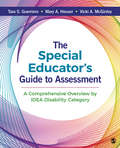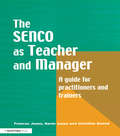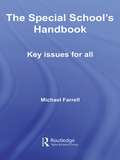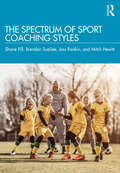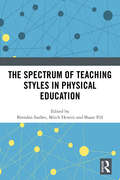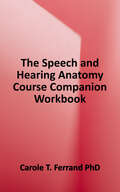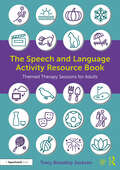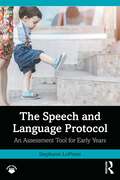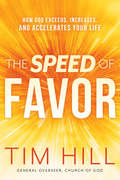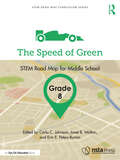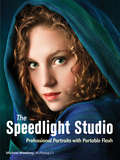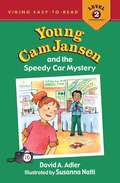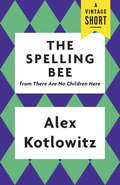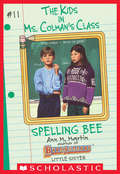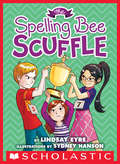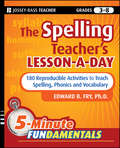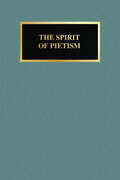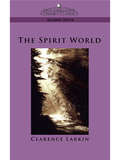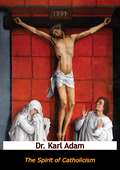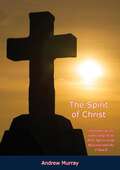- Table View
- List View
The Special Educator′s Guide to Assessment: A Comprehensive Overview by IDEA Disability Category
by Tara S. Guerriero Mary A Houser Vicki A. McGinleySpecial education students often learn about the characteristics of disabilities, but can lack an understanding of the relationship between diagnostic assessment and eligibility for special education services. The Special Educator′s Guide to Assessment: A Comprehensive Overview by IDEA Disability Category focuses on the role that assessment plays in the diagnosis of a disability, determination of eligibility for special education services, and education of students with disabilities to provide a meaningful interconnection between assessment concepts and classroom application for teachers. Authors Tara S. Guerriero, Mary A. Houser, and Vicki A. McGinley want to ensure that future special education teachers have the preparation to provide comprehensive instruction to P-12 students through this text. While special education teachers are often not the ones conducting comprehensive evaluations, it is paramount that they understand their students’ individual characteristics, and understand how assessment is used to determine diagnosis and eligibility. Framing the text around The Individuals with Disabilities Act (IDEA) provides students with concrete standards by which all disabilities are evaluated and regulated in our public educational system. Part I introduces the basic topics of assessment, ethics, and assessment types. Part II moves on to provide diagnostic and eligibility criteria according to IDEA categories that are most commonly diagnosed in an educational setting while Part III describes the criteria for IDEA categories most commonly diagnosed in a medical setting. Features like case studies and sample comprehensive evaluations help bring to life assessment and how it applies in real classrooms. Included with this title: The password-protected Instructor Resource Site (formally known as SAGE Edge) offers access to all text-specific resources, including a test bank and editable, chapter-specific PowerPoint® slides.
The Special Educator′s Guide to Assessment: A Comprehensive Overview by IDEA Disability Category
by Tara S. Guerriero Mary A Houser Vicki A. McGinleySpecial education students often learn about the characteristics of disabilities, but can lack an understanding of the relationship between diagnostic assessment and eligibility for special education services. The Special Educator′s Guide to Assessment: A Comprehensive Overview by IDEA Disability Category focuses on the role that assessment plays in the diagnosis of a disability, determination of eligibility for special education services, and education of students with disabilities to provide a meaningful interconnection between assessment concepts and classroom application for teachers. Authors Tara S. Guerriero, Mary A. Houser, and Vicki A. McGinley want to ensure that future special education teachers have the preparation to provide comprehensive instruction to P-12 students through this text. While special education teachers are often not the ones conducting comprehensive evaluations, it is paramount that they understand their students’ individual characteristics, and understand how assessment is used to determine diagnosis and eligibility. Framing the text around The Individuals with Disabilities Act (IDEA) provides students with concrete standards by which all disabilities are evaluated and regulated in our public educational system. Part I introduces the basic topics of assessment, ethics, and assessment types. Part II moves on to provide diagnostic and eligibility criteria according to IDEA categories that are most commonly diagnosed in an educational setting while Part III describes the criteria for IDEA categories most commonly diagnosed in a medical setting. Features like case studies and sample comprehensive evaluations help bring to life assessment and how it applies in real classrooms. Included with this title: The password-protected Instructor Resource Site (formally known as SAGE Edge) offers access to all text-specific resources, including a test bank and editable, chapter-specific PowerPoint® slides.
The Special Needs Coordinator as Teacher and Manager: A Guide for Practitioners and Trainers
by Kevin Jones Frances Jones Christine SzwedThis text reflects the shift in the SENCO's role from SEN teacher to manager. Written within the context of the most recent government initiatives, it can be used by both special-needs coordinators and by special-educational-needs trainers and advisory staff. In two parts, it explores the range of skills required for the role of special needs coordinator and offers information and advice to develop those skills. Practical activities enable the user to monitor and evaluate special-needs provision in their own school and to implement a structured process of change in partnership with all those involved in meeting special educational needs.
The Special School's Handbook: Key Issues for All (nasen spotlight)
by Michael FarrellGiving an up-to-date picture of the work of special schools, this practical and informative book provides an invaluable and timely companion for anyone teaching or planning to teach in special schools in the United Kingdom. Using case studies of good practice to provide clear suggestions on how special schools may be further developed, the wide-ranging chapters address topics such as: adapting the curriculum to give special schools more flexibility implications of Every Child Matters and multi-professional working organisational changes in special schools the changing roles of staff in the modern special school ways of assessing the progress and achievement of pupils working with parents. With a no-nonsense, non-academic approach, and with each chapter featuring think points and suggestion for further study, The Special School's Handbook contains a wealth of invaluable information, resources and advice and is a handy reference book which staff can dip in and out of at their leisure.
The Spectrum of Sport Coaching Styles
by Shane Pill Brendan SueSee Mitch Hewitt Joss RankinFor the first time, this book applies The Spectrum to sports coaching to become a Spectrum of Coaching Styles. The non-versus approach to pedagogy taken by The Spectrum places athletes or players at the centre of their learning and clearly defines who (player or coach) is making pedagogical decisions in each style. This clarity allows players and coaches to have their teaching behaviours and decision-making clearly defined, and it provides a common language for players, coaches and practitioners to talk about coaching styles and the expected outcomes. For coaches interested in the holistic development of the player/athlete, The Spectrum provides a detailed framework for achieving multiple learning outcomes through cognitive, social, physical, ethical, emotional and social development. Written by coaches for coaches, this book applies Spectrum theory in a coach-specific/friendly way to the following: Introduction to The Spectrum and the sport coach as educator; Summary and detailed description of the 11 coaching styles and their suitability to particular types of coaching episodes; Outlines of the strengths of each style with application examples; and Explanations of coaching to develop reflective practice, self-analysis and error correction, how to coach players to decide on appropriate practice levels or challenge points, player problem solving and solution generation ability. The Spectrum of Sport Coaching Styles is important reading for coaches, athletes, students and lecturers of sports coaching across any sport.
The Spectrum of Sport Coaching Styles
by Shane Pill Brendan SueSee Mitch Hewitt Joss RankinFor the first time, this book applies The Spectrum to sports coaching to become a Spectrum of Coaching Styles. The non-versus approach to pedagogy taken by The Spectrum places athletes or players at the centre of their learning and clearly defines who (player or coach) is making pedagogical decisions in each style. This clarity allows players and coaches to have their teaching behaviours and decision-making clearly defined, and it provides a common language for players, coaches and practitioners to talk about coaching styles and the expected outcomes. For coaches interested in the holistic development of the player/athlete, The Spectrum provides a detailed framework for achieving multiple learning outcomes through cognitive, social, physical, ethical, emotional and social development.Written by coaches for coaches, this book applies Spectrum theory in a coach-specific/friendly way to the following: Introduction to The Spectrum and the sport coach as educator; Summary and detailed description of the 11 coaching styles and their suitability to particular types of coaching episodes; Outlines of the strengths of each style with application examples; and Explanations of coaching to develop reflective practice, self-analysis and error correction, how to coach players to decide on appropriate practice levels or challenge points, player problem solving and solution generation ability. The Spectrum of Sport Coaching Styles is important reading for coaches, athletes, students and lecturers of sports coaching across any sport.
The Spectrum of Teaching Styles in Physical Education
by Shane Pill Brendan SueSee Mitch HewittThis is the first in-depth, practice-focused book to explain ‘spectrum theory’ and its application in physical education and sports coaching. Spectrum theory identifies 11 distinct teaching styles, with decision making as a central characteristic, and allows teachers to select age and developmentally appropriate styles across social, physical, ethical, emotional and cognitive channels. The book brings together leading thinkers in spectrum theory, to demonstrate how it can be applied to improve teaching and learning in PE and coaching. Drawing on real-world research in schools and universities, the book considers the history of spectrum theory, and examines its significance across important areas such as physical education teacher education, sport pedagogy, teacher development, models such as Games Sense and Teaching Games for Understanding, skill acquisition and student learning and perception. Every chapter highlights the practical implications of research in real-world settings and considers how spectrum theory can enhance learning experiences. This book is invaluable reading for all pre-service and in-service school physical education teachers, sports coaches, school pedagogical leaders and college lecturers.
The Speech and Hearing Anatomy Course Companion Workbook
by Carole T. FerrandThis book is an introduction to the anatomy of speech and hearing. It follows the established model of the speech and hearing system most used in Speech and Hearing Anatomy courses. Reference and coloring illustrations, as well as "draw your own" pages are integrated with the narrative of each unit. Following each unit is an extensive self-assessment section that includes multiple choice questions, true/false statements, fill-in-the blanks, matching, and crossword puzzles.
The Speech and Language Activity Resource Book: Themed Therapy Sessions for Adults
by Tracy Broadley JacksonThe Speech and Language Activity Resource Book offers a flexible and readily available set of activities and worksheets designed to support speech and language therapists as they deliver personalised and engaging therapy sessions. With topics based on seasons, hobbies, sports and celebrations, etc, the worksheets can be selected to suit a client’s interests as well as targeting specific skills and needs. The engaging activities encourage conversation and participation, promoting skill development in a way that is easily translated into everyday communication. Key features of this book include: A range of activities, arranged by level of difficulty, that can be selected based on the client’s individual need A person-centred approach to therapy, enabling the time-poor practitioner the opportunity to personalise their care with ease Photocopiable and downloadable sheets that can be completed during therapy sessions or sent out to the client for home practice, as well as blank worksheets that can be used to create new, appropriate activities Easily adaptable for group sessions, one-on-one therapy sessions and home activities, this is an essential tool for speech and language therapists and occupational therapists, as well as families and other practitioners supporting adults with a range of acquired communication difficulties.
The Speech and Language Protocol: An Assessment Tool for Early Years
by Stephanie LoPrestiThis valuable book addresses the common problems faced by speech‑language pathologists, offering solutions and strategies for more effective service delivery.Stephanie LoPresti introduces ‘The Protocol,’ a child development‑based approach that merges principles from developmental psychology and speech‑language pathology. The book covers a wide range of speech and language issues, including receptive, expressive, pragmatic, feeding, and play development, making it a versatile resource for clinicians. It is designed to be easy to use, with movable elements that adapt to a child’s progress from short‑ to long‑term milestones and goals. It emphasizes the concept of the zone of proximal development, ensuring that clinicians work with clients just above their current level of functioning, leading to meaningful progress.Accompanied by downloadable worksheets to assess progress, it will be an essential resource for all speech and language pathologists, particularly those working with young children. It will also be useful to students and educators in the field of speech‑language pathology seeking evidence‑based strategies for working with clients, as well as healthcare professionals, researchers, and educators interested in child development and language acquisition.
The Speed of Favor: How God Exceeds, Increases, and Accelerates Your Life
by Tim HillThe end times could be the beginning of your greatest blessing. Rather than Christians living in fear of what&’s to come, Tim Hill invites them to move to a new level of trust and confidence in God and a higher level of faith and expectation as they discover the accelerated season of favor God has promised for the days ahead. Flying in the face of the doomsayers who forecast the demise of the church, Hill recovers an ancient prophetic promise of provision. Sharing how this revelation affected his own family, finances, and faith, Hill challenges readers to break free from a powerless, status-quo Christian life filled with anxiety, depression, and hopelessness as they discover how God&’s blessings and provision precede them and enable them to make a difference in others&’ lives. The Amos 9:13 promise is not about prosperity. Neither is it a word for just one season. It is a way of life. Hill encourages readers to welcome it, embrace it, and claim it as their own. &“Yes indeed, it won&’t be long now.&” God&’s Decree. &“Things are going to happen so fast your head will swim, one thing fast on the heels of the other. You won&’t be able to keep up. Everything will be happening at once—and everywhere you look, blessings! Blessings like wine pouring off the mountains and hills.&” —Amos 9:13, The Message
The Speed of Green, Grade 8: STEM Road Map for Middle School (STEM Road Map Curriculum Series)
by Carla C. Johnson Erin E. Peters-Burton Janet B. WaltonWhat if you could challenge your eighth graders to design a racing vehicle with minimum environmental impact, while exploring the role of renewable and non-renewable energy sources? With this volume in the STEM Road Map Curriculum Series, you can! The Speed of Green outlines a journey that will steer your students toward authentic problem solving while grounding them in integrated STEM disciplines. Like the other volumes in the series, this book is designed to meet the growing need to infuse real-world learning into K–12 classrooms. This interdisciplinary, eight-lesson module uses project- and problem-based learning to help students explore the potential role of renewable and non-renewable energy sources in transportation, with an emphasis on the auto industry. Using their understanding of the engineering design process (EDP), scientific concepts, and environmental conservation considerations, student teams will develop a plan for a competitive automobile racing team to fuel its vehicle with minimal environmental impact. To support this goal, students will do the following: · Identify finite energy resources and distinguish between these and renewable energy sources, and identify implications of the use of those fuel sources on the environment; · Conduct life cycle analyses (LCAs) of various fuel sources and apply the results to make decisions about the effects of various fuel sources; · Identify several ways that carbon-based fuels have impacted the U.S. economy and foreign relations; · Identify the effects of human activities on the biosphere with an emphasis on the effects of the widespread use of carbon-based fuels; · Apply the engineering design process (EDP) to solve a problem, and design and build a small-scale electric vehicle; · Synthesize their learning and working collaboratively by creating and presenting a plan for a race team that minimizes its environmental impact; · Create an engaging presentation incorporating oral presentations and visual displays to present projects to an audience of peers, teachers, and industry professionals. The STEM Road Map Curriculum Series is anchored in the Next Generation Science Standards, the Common Core State Standards, and the Framework for 21st Century Learning. In-depth and flexible, The Speed of Green can be used as a whole unit or in part to meet the needs of districts, schools, and teachers who are charting a course toward an integrated STEM approach.
The Speedlight Studio
by Michael MowbrayIn this book, Michael Mowbray shows readers how to set up a completely speedlight-based portrait photography studio. He goes in depth regarding gear and techniques, providing photographers with scores of example portraits and lighting diagrams to make it easy to follow along and replicate the portrait lighting effects that he shows. Readers will learn about selecting speedlights (Mowbray covers Canon, Nikon, and third-party units), learning standard operations, and working with the units on the camera’s hot shoe (a connectivity device on top of the camera) or in the periphery for more flexible, controllable results. Readers will learn why modifying the light from speedlights will produce a lot more bang for their buck and will also discover a host of tools-commercial and DIY-that can be used to change the direction, color, and quality of light for the ultimate artistic control.
The Speedlight Studio
by Michael MowbrayIn this book, Michael Mowbray shows readers how to set up a completely speedlight-based portrait photography studio. He goes in depth regarding gear and techniques, providing photographers with scores of example portraits and lighting diagrams to make it easy to follow along and replicate the portrait lighting effects that he shows. Readers will learn about selecting speedlights (Mowbray covers Canon, Nikon, and third-party units), learning standard operations, and working with the units on the camera’s hot shoe (a connectivity device on top of the camera) or in the periphery for more flexible, controllable results. Readers will learn why modifying the light from speedlights will produce a lot more bang for their buck and will also discover a host of tools-commercial and DIY-that can be used to change the direction, color, and quality of light for the ultimate artistic control.
The Speedlight Studio
by Michael MowbrayIn this book, Michael Mowbray shows readers how to set up a completely speedlight-based portrait photography studio. He goes in depth regarding gear and techniques, providing photographers with scores of example portraits and lighting diagrams to make it easy to follow along and replicate the portrait lighting effects that he shows. Readers will learn about selecting speedlights (Mowbray covers Canon, Nikon, and third-party units), learning standard operations, and working with the units on the camera's hot shoe (a connectivity device on top of the camera) or in the periphery for more flexible, controllable results. Readers will learn why modifying the light from speedlights will produce a lot more bang for their buck and will also discover a host of tools-commercial and DIY-that can be used to change the direction, color, and quality of light for the ultimate artistic control.
The Speedy Car Mystery (Young Cam Jansen #16)
by David A. Adler Susanna NattiAt her school's Green Fair, Cam and her friends are learning how to keep the earth green. Everyone is having fun at the exhibits until a student's remote controlled car goes missing! Was it stolen? It's up to Cam and her amazing memory to find Speedy.
The Spelling Bee
by Alex KotlowitzAn eBook short.A selection from Alex Kotlowitz's masterpiece of immersive reportage There Are No Children Here, the harrowing coming-of-age story of two children in Chicago's Henry Horner Public Housing Complex. In "The Spelling Bee," as Pharoah returns to school, his dreams come up against the realities of his neighborhood. Pharoah is small of stature, has a stutter, and frequently reads at night until his eyes hurt. He has his mother's open and generous smile, and his father's charm and keen intellect. As he enters fourth grade, he sets a solemn goal for himself: to become a spelling bee champion. Award-winning journalist Alex Kotlowitz follows Pharoah for two years, as he tries desperately to succeed at school while navigating the perils of his devastated neighborhood, a place marked by deep need and neglect, along with unrelenting violence. For Pharoah, spelling is just the beginning. This is a dramatic and groundbreaking portrait of poverty, the story of growing up in the other America.
The Spelling Bee (The Kids in Ms. Colman's Class #11)
by Ann M. MartinFrom the bestselling author of the generation-defining series The Baby-sitters Club comes a series for a new generation!School is always fun in Ms. Colman's class! Hank Reubens likes math problems and puzzles and games. he is not afraid when Ms. Colman announces the big spelling bee. But there is a war going on in the second grade. The girls want Debbie Dvorak to win the spelling bee. And the boys want Hank to win. Can Hank win the spelling bee for the boys?
The Spelling Bee Scuffle (Sylvie Scruggs #3)
by Lindsay EyreIn the third book in this laugh-out-loud series, Sylvie Scruggs proves she can turn any situation into trouble -- including the school spelling bee!Cherry Hill Elementary has always had two baseball fields, one for Sylvie Scruggs's fourth-grade-and-under friends, and one for Jamie Redmond's fifth-grade crew. When Jamie's field is demolished for a kindergarten playground, the fifth graders want to take over the fourth-grade space. Finally, Sylvie and Jamie make a bet: Whoever wins the school spelling bee wins the baseball diamond too. Sylvie knows her friend Miranda will be the champion, no question, and the field will be safe for her team.But then Josh Stetson beats Miranda in the class bee, which means he'll compete against the fifth-graders for the school title. As Sylvie tries to help Josh prepare for the big event, friendships get strained, secret deals get made, and matters spin WAY out of control. How far will Sylvie go to win the field for her friends?
The Spelling Teacher's Lesson-a-Day
by Fry Edward B.The effective and fun-filled way to teach spelling to elementary students The Spelling Teacher's Lesson-a-Day gives teachers 180 engaging and ready-to-use lessons-one for each day of the school year-that boost spelling skills in students grades 3-6. These lessons may be used as "sponge" or "hook" activities (five-minute lessons to start off each school day) or teachers may simply pick and choose activities from within the book for the occasional spelling lesson. Fry teaches spelling patterns by contrasting homophones (like-sounding words) to help students recognize these spelling patterns in more complex words. He also boosts students' spelling skills by demystifying contractions, abbreviations, capitalization, silent letters, suffixes and prefixes, and more. Offers an easy-to-use method for teaching spelling that has been proven to be effective Includes 180 ready-to-use, reproducible lessons-one for each day of the school year A new volume in the new series 5-Minute FUNdamentals This book is designed to be used by classroom teachers, homeschoolers, tutors, and parents.
The Spirit Of Pietism
by Robert J KoesterWhat is Pietism?In the late 17th century, a movement began in Germany that would shake up an already fragile Lutheran church. Pietism, as the movement came to be known, departed from many of the orthodox Christian practices of the day. An emphasis on morals and individual piety over the Scriptures and sacraments led to a rift in the church that hasn’t been fully repaired.But why did Pietism start? What did the Pietist leaders hope to accomplish? What is the true essence of Pietism?Author and pastor Robert Koester answers these questions and more in this in-depth study of this impactful theological movement. The Spirit of Pietism also debunks hasty generalizations about Pietism and offers practical lessons for 21st-century Christians. With a balanced narrative approach and readable style, this is an engaging book from start to finish!
The Spirit World
by Clarence LarkinIn this day of the revival of "Spiritism," when so many... are longing to communicate with the dead, and are resorting to forbidden means to that end; a day in which science is trying to discover whether there is another world than this, and whether men live after death... it seems timely that a book should be written to show what the Holy Scriptures have revealed of the "World of Spirits." -from The Second Coming of Christ. The Reverend Clarence Larkin was one of the most widely influential pop theologians of the early twentieth century, and his works remain intriguing explorations of Christian philosophy today. First published in 1921, this fascinating book explores the depiction of angels, demons, and other spirits in the Bible, and features illustrations of "Satan's Throne," "Angels Appearing to Abraham," "Christ Casting Out a Demon," "The Witch of Endor," and more. Readers in religion, mythology, and classic literature will be riveted. Also available from Cosimo Classics: Larkin's The Second Coming of Christ, Rightly Dividing the Word, and The Book of Revelation.
The Spirit of Catholicism
by Dr Karl Adam Dom Justin McCannThis is the 1929 English translation of the original German text first published in 1924 and authored by one of the world’s most distinguished Christian philosophers, Dr. Karl Adam.This book is a brilliant and evocative study of the fundamental concepts of the Catholic Faith, from its tenets, its historical development and the role of the Church in world society.For many on the outside, Catholicism, according to Dr. Adam, represents a daunting and somewhat foreign confused mass of conflicting forces that has somehow survived the tests of time. Catholicism is simultaneously new yet quite old; holy yet corrupt; hierarchical yet personal; dogmatic yet utilitarian, and so on.How can someone outside the Church get a good grasp on the essence of Catholicism when it is so vast and seemingly complex? Those attempting to grasp the very heart and spirit of Catholicism should read Karl Adam’s book, which is a most elegant and concise exploration of the faith and an attempt to address these ambiguities.What are the fundamental attributes of the Catholic Church? What is the source from which it has drawn vigor and life through its two thousand years of life on earth? What are the secret sources of its incredible vitality in the world today? The author answers these and many other questions about the nature and structure of the Church. He examines the essential nature of the Catholic Church from the basic premise that it was expressly founded by Christ, traces its historical development and analyzes its actual functioning through the ages.
The Spirit of Christ: Thoughts On The Indwelling Of The Holy Spirit In The Believer And The Church
by Andrew MurrayThe Spirit of Christ: Thoughts on the Indwelling of the Holy Spirit in the Believer and the Church by Andrew Murray is a profound and enlightening exploration of the Holy Spirit’s role in the life of believers and the Church. Murray, a revered Christian writer and pastor, delves deeply into the transformative power of the Holy Spirit, offering readers a rich theological and devotional understanding of this vital aspect of Christian faith.In this inspiring work, Murray discusses the nature and work of the Holy Spirit, emphasizing His indwelling presence in every believer and His unifying power within the Church. Through biblical insights and practical applications, Murray illustrates how the Holy Spirit empowers Christians to live victorious and fruitful lives, guiding them into all truth and enabling them to reflect Christ’s love and character.Murray’s thoughtful reflections cover various dimensions of the Holy Spirit’s ministry, including the Spirit’s role in regeneration, sanctification, and spiritual growth. He also addresses the importance of the Spirit’s gifts and fruit, encouraging believers to seek a deeper, more intimate relationship with God through the Spirit’s abiding presence.The Spirit of Christ is a call to experience the fullness of the Holy Spirit’s indwelling, urging readers to surrender fully to God’s transformative work. Murray’s accessible and heartfelt writing invites believers to embrace the Spirit’s power and guidance, fostering a vibrant and dynamic faith.This book is essential reading for anyone desiring to deepen their understanding of the Holy Spirit and His work within the Christian life and the Church. The Spirit of Christ offers profound spiritual insights and practical wisdom, making it a timeless resource for personal devotion, group study, and spiritual growth.Andrew Murray’s legacy as a spiritual guide shines brightly in this work, providing readers with a compelling vision of life empowered by the Holy Spirit. Through The Spirit of Christ, believers are encouraged to walk in the fullness of God’s presence, experiencing the transformative impact of the Spirit in every aspect of their lives.
The Spirit of Generosity: Shaping IU Through Philanthropy
by Curtis R Simic Sandra BateHow does commitment to a university become so significant that it prompts giving that can impact generations of students? Are donors motivated by their own experiences, memories of friends and mentors, or aspirations to fund cutting edge research, teaching, and service? At Indiana University, authentic and trusting partnerships pave the way for donors to invest in the causes they believe in, resulting in the creation of knowledge, of opportunity, and of beauty across campus. The Spirit of Generosity: Shaping IU through Philanthropy shares compelling stories of thirteen partnerships that have advanced the common good at Indiana University. These relationships, though unique, are founded on the understanding that gifts reflect the values and dreams of donors. Whether giving endows a chair, funds scholarships, or renovates buildings, it is infused with deep meaning and leaves a lasting impact on the university community. This book honors the generosity of spirit that motivates philanthropy and helps Indiana University fulfill its mission to provide broad access to education, excel in innovative research and teaching, and improve the human condition.
